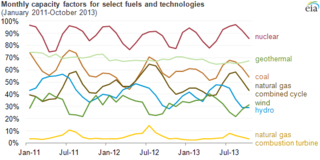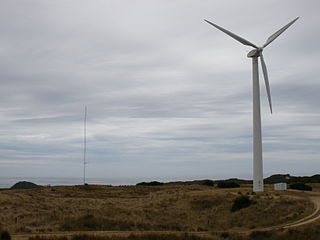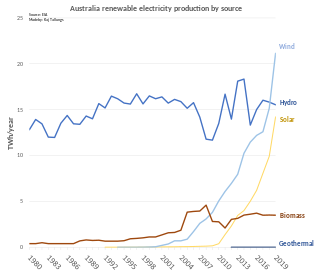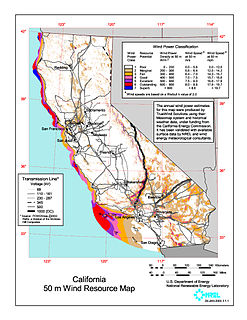
Pumped-storage hydroelectricity (PSH), or pumped hydroelectric energy storage (PHES), is a type of hydroelectric energy storage used by electric power systems for load balancing. The method stores energy in the form of gravitational potential energy of water, pumped from a lower elevation reservoir to a higher elevation. Low-cost surplus off-peak electric power is typically used to run the pumps. During periods of high electrical demand, the stored water is released through turbines to produce electric power. Although the losses of the pumping process make the plant a net consumer of energy overall, the system increases revenue by selling more electricity during periods of peak demand, when electricity prices are highest. If the upper lake collects significant rainfall or is fed by a river then the plant may be a net energy producer in the manner of a traditional hydroelectric plant.

The Portland wind farm is one of Australia's largest wind farms. Located on the coast of south-western Victoria near the city of Portland, it consists of four separate sites, all of which have been completed as of 2015. Completion of the entire 195 MW project was expected in 2011, at a capital cost of A$330 million.

The net capacity factor is the unitless ratio of actual electrical energy output over a given period of time to the theoretical maximum electrical energy output over that period. The theoretical maximum energy output of a given installation is defined as that due to its continuous operation at full nameplate capacity over the relevant period. The capacity factor can be calculated for any electricity producing installation, such as a fuel consuming power plant or one using renewable energy, such as wind or the sun. The average capacity factor can also be defined for any class of such installations, and can be used to compare different types of electricity production.
Crookwell Wind Farm, located at Crookwell west of Goulburn, New South Wales, consists of eight 600 kW wind turbines giving a total capacity of 4.8 MW. It was the first grid-connected wind farm in Australia when built by Pacific Power in 1998. It is now owned by Tilt Renewables.

Hybrid power are combinations between different technologies to produce power.

Woolnorth Wind Farm is a wind power complex, comprising two wind farms — Bluff Point and Studland Bay. They are located at the Woolnorth property at Woolnorth, in the far north-west of Tasmania, Australia. Both wind farms are operated by Woolnorth Wind Farm Holdings, a joint venture between Hydro Tasmania and Shenhua Group.
Cathedral Rocks Wind Farm is a wind power station located about 30 km west of Port Lincoln in South Australia, near the southern tip of the Eyre Peninsula. It has 33 wind turbines of 2 MW each, with a combined generating capacity of 66 MW of electricity. The site covers an area of about 29 km², with a coastal exposure of nearly 11 km and is private farming land. The wind farm was commissioned in September 2005.

Huxley Hill Wind Farm is a wind power station at King Island, Tasmania, Australia, of around 1600 residents, owned by Hydro Tasmania, which supplements the four diesel generators with a combined capacity of 6 MW at Currie Power Station. King Island also has a 100 kW solar capacity provided with monocrystaline solar panels on dual-axis arrays.

Wind power is one of the main renewable energy sources in Australia and contributed 10% of electricity supplied in 2020, with 37.5% total renewable energy supply. Australia has greatly distinguished conditions for harvesting wind power. Abundant wind resources may be located close to population centres in the southern parts of the country and on the slopes of the Great Dividing Range in the east.

The production of renewable energy in Scotland is a topic that has come to the fore in technical, economic, and political terms during the opening years of the 21st century. The natural resource base for renewable energy is high by European, and even global standards, with the most important potential sources being wind, wave, and tide. Renewables produced the equivalent of 97.4% of Scotland's electricity consumption in 2020, mostly from the country's wind power.

Wind power became a significant energy source within South Australia over the first two decades of the 21st century. In 2015, there was an installed capacity of 1,475 MW, which accounted for 34% of electricity production in the state. This accounted for 35% of Australia's installed wind power capacity. In 2021, there was an installed capacity of 2052.95 MW, which accounted for 42.1% of the electricity production in the state in 2020.

Renewable energy in Australia includes wind power, hydroelectricity, solar PV, heat pumps, geothermal, wave and solar thermal energy.

Lake Bonney Wind Farm, in South Australia, was built in three stages. Stage 1 comprises 46 turbines each having a rated capacity of 1.75 MW and was finished in March 2005. Construction of Stage 2 began in November 2006 and was finished around April 2008. Stage 2 comprises 53 turbines of 3 MW. Stage 3 comprises 13 turbines of 3 MW of total 39 MW). Stage 3 construction commenced in February 2009 and was commissioned in September 2009.

Wind power in Texas, a portion of total energy in Texas, consists of over 150 wind farms, which together have a total nameplate capacity of over 30,000 MW. If Texas were a country, it would rank fifth in the world: The installed wind capacity in Texas exceeds installed wind capacity in all countries but China, the United States, Germany and India. Texas produces the most wind power of any U.S. state. According to the Electric Reliability Council of Texas (ERCOT), wind power accounted for at least 15.7% of the electricity generated in Texas during 2017, as wind was 17.4% of electricity generated in ERCOT, which manages 90% of Texas's power. ERCOT set a new wind output record of nearly 19.7 GW at 7:19 pm Central Standard Time on Monday, January 21, 2019.

Wind power in California had initiative and early development during Governor Jerry Brown's first two terms in the late 1970s and early 1980s. The state's wind power capacity has grown by nearly 350% since 2001, when it was less than 1,700 MW. In 2016, wind energy supplied about 6.9% of California's total electricity needs, or enough to power more than 1.3 million households. Most of California's wind generation is found in the Tehachapi area of Kern County, California, with some large projects in Solano, Contra Costa and Riverside counties as well. California is among the states with the largest amount of installed wind power capacity. In recent years, California has lagged behind other states when it comes to the installation of wind power. It was ranked 4th overall for wind power electrical generation at the end of 2016 behind Texas, Iowa, and Oklahoma. As of 2019, California had 5,973 megawatts (MW) of wind power generating capacity installed.

Wind power in Scotland is the fastest-growing renewable energy technology, with 9,347 MW of installed wind power capacity as of June 2020. This included 8,366 MW from onshore wind in Scotland and 981 MW of offshore wind generators.

Wind power constitutes a small but growing proportion of New Zealand's electricity. As of December 2020, wind power accounts for 690 MW of installed capacity and over 5 percent of electricity generated in the country.

Keadby Power Station is a 734 MWe gas-fired power station near Scunthorpe in North Lincolnshire. It lies near the B1392 and the River Trent, and the Scunthorpe-Grimsby railway. Also nearby is the Stainforth and Keadby Canal, which is part of the Sheffield and South Yorkshire Navigation. The station is operated by SSE Thermal.
The Macarthur Wind Farm is a wind farm located in Macarthur, Victoria, Australia, near Hamilton, 260 km west of Melbourne. It is on a 5,500 ha site which has an installed capacity of 420 megawatts (MW). Based on a capacity factor of around 35%, it is estimated that the long-term average generation will be approximately 1,250 GWh per year. Its actual capacity factor is much lower, with a historical average of 26.29% since 2013.

The electricity sector in Australia was historically dominated by coal-fired power stations, but renewables are forming a rapidly growing fraction of supply.

















